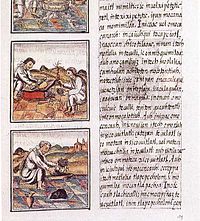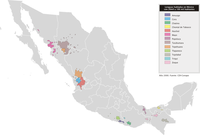Languages of Mexico: Difference between revisions
No edit summary |
JorgeAranda (talk | contribs) mNo edit summary |
||
| Line 1: | Line 1: | ||
[[Mexico]] has a significant linguistic diversity. In addition to [[Spanish language|Spanish]],the government recognizes 63 indigenous [[Amerindian languages]] as '''national languages'''. According to the [[National Commission for the Development of Indigenous Peoples|Commission for the Development of Indigenous Peoples]] (CDI), while 13% of the population is of Amerindian origin, only 6% speak an indigenous language. |
[[Mexico]] has a significant linguistic diversity. In addition to [[Spanish language|Spanish]], the government recognizes 63 indigenous [[Amerindian languages]] as '''national languages'''. According to the [[National Commission for the Development of Indigenous Peoples|Commission for the Development of Indigenous Peoples]] (CDI), while 13% of the population is of Amerindian origin, only 6% speak an indigenous language. |
||
{| class="toc" cellpadding=0 cellspacing=2 width=200px style="float:right; margin: 0.5em 0.5em 0.5em 1em; padding: 0.5e text-align:left;clear:all; margin-left:3px; font-size:90%" |
{| class="toc" cellpadding=0 cellspacing=2 width=200px style="float:right; margin: 0.5em 0.5em 0.5em 1em; padding: 0.5e text-align:left;clear:all; margin-left:3px; font-size:90%" |
||
Revision as of 14:42, 2 June 2010
Mexico has a significant linguistic diversity. In addition to Spanish, the government recognizes 63 indigenous Amerindian languages as national languages. According to the Commission for the Development of Indigenous Peoples (CDI), while 13% of the population is of Amerindian origin, only 6% speak an indigenous language.
| Indigenous languages of Mexico | |
| Language | Speakers |
|---|---|
| Nahuatl (Mexicano, Mexicanero, Nahuat, Nahual, Melatahtol) | 1,376,026 |
| Yucatec Maya (Maaya t'aan) | 759,000 |
| Mixtec (Tu'un sávi) | 423,216 |
| Zapotec (Binizaa) | 410,901 |
| Tzeltal Maya (K'op o winik atel) | 371,730 |
| Tzotzil Maya (Batsil k'op) | 329,937 |
| Otomí (Hñä hñü) | 239,850 |
| Totonac (Tachihuiin) | 230,930 |
| Mazatec (Ha shuta enima) | 206,559 |
| Ch'ol (Mayan) (Winik) | 185,299 |
| Huastec (Téenek) | 149,532 |
| Chinantec (Tsa jujmí) | 125,706 |
| Mixe (Ayüük) | 115,824 |
| Mazahua (Jñatho) | 111,840 |
| Tarascan (P'urhépechas) | 105,556 |
| Tlapanec (Me'phaa) | 98,573 |
| Tarahumara (Rarámuri) | 75,371 |
| Amuzgo (Tzañcue) | 43,761 |
| Chatino (Cha'cña) | 42,791 |
| Tojolab'al (Tojolwinik otik) | 43,169 |
| Popoluca (Zoquean) (Tuncápxe) | 54,004 |
| Chontal de Tabasco (Yokot t'an) | 43,850 |
| Huichol (Wixárika) | 35,724 |
| Mayo (Yoreme) | 32,702 |
| Tepehuán (O'odham) | 31,681 |
| Trique (Tinujéi) | 24,491 |
| Cora (Naáyarite) | 17,086 |
| Popoloca (Oto-manguean) | 18,926 |
| Huave (Ikoods) | 15,993 |
| Cuicatec (Nduudu yu) | 12,610 |
| Yaqui (Yoreme) | 14,162 |
| Q'anjob'al | 10,833 |
| Tepehua (Hamasipini) | 10,625 |
| Pame (Xigüe) | 9,768 |
| Mam (Qyool) | 8,739 |
| Chontal de Oaxaca (Slijuala sihanuk) | 5,534 |
| Chuj | 2,143 |
| Tacuate (Mixtec de Santa María Zacatepec) (Tu'un Va'a) | 2,067 |
| Chichimeca jonaz (Úza) | 1,987 |
| Guarijío (Makurawe) | 1,905 |
| Chocho (Runixa ngiigua) | 1,078 |
| Pima Bajo (O'odham) | 836 |
| Q'eqchí (Q'eqchí) | 835 |
| Lacandón (Hach t'an) | 731 |
| Jakaltek (Poptí) (Abxubal) | 584 |
| Matlatzinca/Ocuilteco (Tlahuica) | 522 |
| Seri (Cmiique iitom) | 518 |
| Ixcatec | 406 |
| K'iche' | 286 |
| Kaqchikel | 230 |
| Paipai (Akwa'ala) | 221 |
| Cucapá (Es péi) | 206 |
| Mototzintleco (Qatok) | 186 |
| Kumiai (Ti'pai) | 185 |
| Pápago (Tohono O'odham) | 153 |
| Kikapú (Kikapooa) | 144 |
| Ixil | 108 |
| Cochimí (Laymón, mti'pá) | 96 |
| Kiliwa (Ko'lew) | 55 |
| Aguacatec | 27 |
| Other languages 1 | 337 |
| Only includes population 5 and older. Source: INEGI (2005) [1] | |
Legislation
Spanish is the de facto language spoken by the vast majority of Mexicans, though the Mexican government does not legislate it as an official language. Nonetheless, the second article of the 1917 Constitution defines the country as multicultural, recognizes the right of the indigenous peoples to "preserve and enrich their languages" and promotes "bilingual and intercultural education".
In 2003 Congress approved the General Law of Linguistic Rights of Indigenous Peoples (in Spanish), which recognizes that Mexico's history makes its indigenous languages, "national languages". Accordingly, they "have the same validity [as Spanish] in their territory, location and context". At the same time, legislators made no specific provisions for the official or legal status of the Spanish language. This law means that indigenous peoples can use their native language in communicating with government officials and request official documents in that language. The Mexican state supports the preservation and promotion of the use of the national languages through the activities of the National Institute of Indigenous Languages [2].
Mexico has about six million citizens who speak indigenous languages. That is the second-largest group in the Americas after Peru. However, a relatively small percentage of Mexico's population speaks an indigenous language compared to other countries in the Americas, such as Guatemala (42.8%), Peru (35%), and even Ecuador (9.4%), Panama (8.3%) [3], Paraguay and Bolivia.
The only single indigenous language spoken by more than a million people in Mexico is the Nahuatl languages. Nahuatl is one of the native American languages with a large population of native speakers, along with Quechua, Aymara and Guaraní and some Mayan languages.
History

The slow process of replacing Mexico's indigenous languages with Spanish began with the arrival of Spanish forces and colonists in Mexico in the 16th century. Some monks and priests attempted to describe and classify indigenous languages with Spanish. Philip II of Spain decreed in 1570 that Nahuatl should become the official language of the colonies of New Spain in order to facilitate communication between the Mexican and natives of the colonies. However, in 1696 Charles II reversed that policy and banned the use of any languages other than Spanish throughout the Mexican Empire. (Cifuentes, 1998). Beginning in the 1700s, decrees ordering the "Hispanization" of indigenous populations became more numerous and Mexican colonizers no longer learned the indigenous languages.
After the independence the government initiated an educational system with the primary aim of Hispanization of the native populations. This policy was based on the idea was that this would help the indigenous peoples become a more integrated part of the new Mexican nation[citation needed].
Except for the Second Mexican Empire, led by the Habsburg Maximilian I, no Mexican government tried to prevent the loss of indigenous languages during the 19th century. [citation needed]
In 1889, Antonio García Cubas estimated that 38% of Mexicans spoke an indigenous language, down from 60% in 1820. By the end of the 20th century, this figure had fallen to 6%.
For most of the 20th century successive governments denied native tongues the status of valid languages. Indigenous students were forbidden to speak their native languages in school and were often punished for doing so[citation needed].
In 1992 the fourth article of Mexico's constitution was amended to reinforce the nation's pluricultural nature by giving the State the obligation to protect and nurture the expressions of this diversity. On June 14, 1999, the Council of Writers in Indigenous Languages presented Congress with a document entitled "Suggested legal initiatives towards linguistic rights of indigenous peoples and communities", with the goal of beginning to protect the linguistic rights of indigenous communities. The Ley General de Derechos Lingüísticos de los Pueblos Indígenas was passed in December 2002, establishing a framework for the conservation, nurturing and development of indigenous languages. Critics claim that the law's complexity makes enforcement difficult. (Cuevas, 2004: 13).
Classification
The following is a classification of the 65 indigenous languages grouped by family:
Language families with members north of Mexico
Language families with all known members in Mexico
- Oto-Manguean languages:
- Oto-pamean branch: Northern Pame, Southern Pame, Chichimeca Jonaz, Otomí, Mazahua, Matlatzinca and Ocuiltec.
- Popolocan branch: Popoloca language, Chocho, Ixcatec language*, Mazatecan languages
- Tlapanec-Subtiaban branch: Me'phaa
- Amuzgoan branch: Amuzgo de Guerrero, Amuzgo de Oaxaca
- Mixtecan branch: Mixtecan languages, Cuicatec and Trique language.
- Chatino-Zapoteca family: Chatino (and its dialects), Zapotec languages.
- Chinantec branch: Chinantec (and its dialects)
- Chiapaneca-mangue branch: Chiapaneco*
- Mixe-Zoquean languages:
- Zoque languages
- Mixe languages
- Popoluca (Texistepec Popoluca, Sierra Popoluca (Both Zoquean) and Sayula Popoluca Oluta Popoluca (Both Mixean))
Language family with members south of Mexico
- Mayan languages:
- Huastecan branch: Wastek language,
- Yucatecan branch: Yukatek Maya, Lacandón,
- Cholan branch: Ch'ol language, Chontal Maya language, Tzeltal language, Tzotzil language,
- Qanjobalan-Chujean branch: Chuj language, Tojolabal language, Q'anjob'al language, Jakaltek, Motozintlec, Akatek language
- Quichean-Mamean branch: Mam language, Tektitek language, Ixil, K'iche' language, Kaqchikel and Q'eqchi'.
- Seri
- Tequistlatecan languages: Lowland Chontal, Highland Chontal
- P'urhépecha
- Huave
*In danger of extinction.
Other languages
Mexico's "pluricultural" makeup is rooted in its indigenous people, something the Constitution explicitly recognizes. However, other than Spanish, the government does not recognize any other non-indigenous language spoken by immigrants and their descendants, even if they have more native speakers than some of the 62 national languages. Historically, Mexican laws have restricted or prohibited the use of foreign languages in mass media (radio and TV) on public road signs, business storefronts and advertising billboards. [citation needed]
The non-indigenous languages spoken in Mexico include English (by English-speaking immigrants, as well as by the residents of border states). One example of this group is the American Mormon colony of Nueva Casas Grandes in Chihuahua, which settled in the late 1800s. German (spoken mainly in Mexico City and Puebla), Arabic, Russian, Veneto (in Chipilo), French, Occitan, Catalan, Basque, Galician, Asturian, Chinese, Hebrew, Korean, Ladino, Plautdietsch, Armenian and other languages are spoken by smaller numbers. Some of these languages (such as Veneto, French and Plautdietsch) are spoken in isolated communities or villages. The rest are spoken by immigrants or their descendants who tend to live in the larger cities and towns. Many of these languages have significantly more speakers than those of indigenous language speakers in Mexico, such as German dialects, Italian dialects and French dialects, but they are not protected by law.
As far as second languages go, a relatively large number of educated Mexicans (and those with little or no education who have immigrated to the US and returned) have different degrees of fluency in English; a much smaller part of the population knows French and Italian, which being Romance languages just as Spanish, are relatively easy for native Spanish speakers to learn.
References
- Instituto Nacional de Lenguas Indígenas [INALI] (14 January, 2008). "Catálogo de las lenguas indígenas nacionales: Variantes lingüísticas de México con sus autodenominaciones y referencias geoestadísticas" (PDF online reproduction). Diario Oficial de la Federación. 652 (9). México, D.F.: Imprenta del Gobierno Federal, SEGOB: pp.22–78 (first section), 1–96 (second section), 1–112 (third section). OCLC 46461036.
{{cite journal}}:|pages=has extra text (help); Check date values in:|date=(help)CS1 maint: date and year (link) Template:Es icon - Cifuentes, Bárbara (1998): Letras sobre voces. Multilingüismo a través de la historia. Centro de Investigaciones y Estudios Superiores en Antropología Social - Instituto Nacional Indigenista. Historia de los Pueblos Indígenas de México. México. ISBN 968-496-338-6
- Cuevas, Susana (2004): Ley de Derechos Lingüísticos en México. En http://www.linguapax.org/congres04/pdf/4_cuevas.pdf. Accessed in August 2006.
- The corresponding article (Lenguas de México) on the Spanish Wikipedia (revision as of August 11, 2006).
External links
{{{inline}}}
- CDI
- "¿Qué lengua hablas?", a portal that contains multimedia files of phrases spoken in some of the national indigenous languages.
- Ethnologue report for Mexico
- General Law of Linguistic Rights of Indigenous Peoples (in Spanish)
Template:Link FA jose loves food



